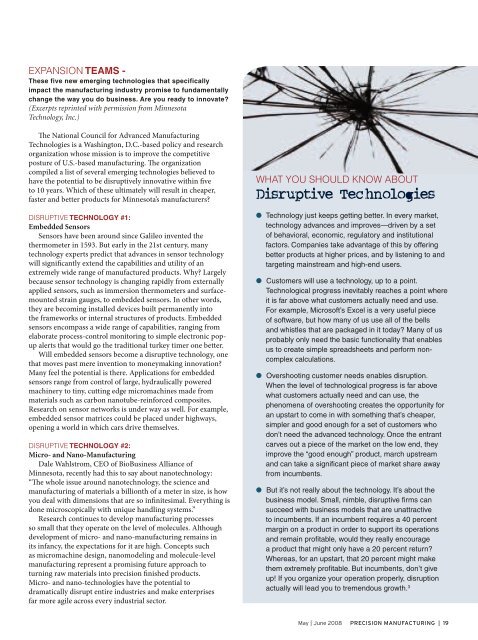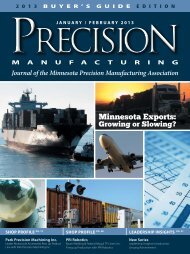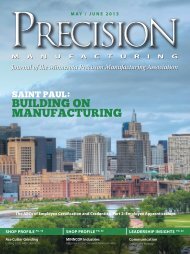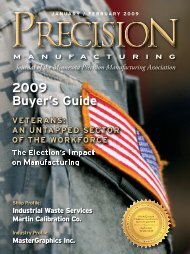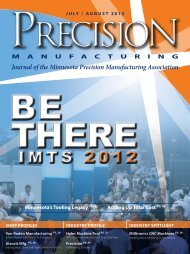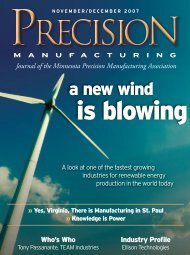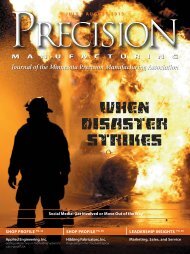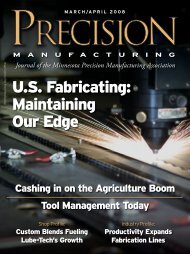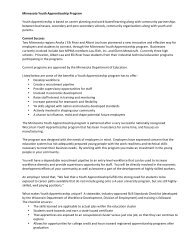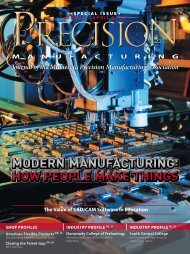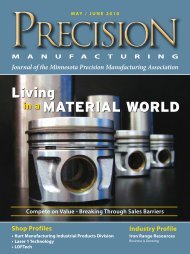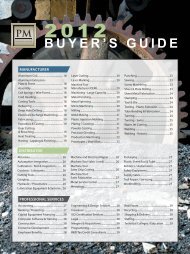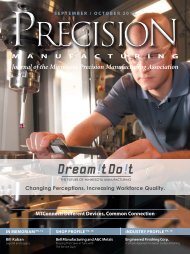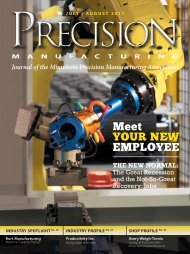Aerospace in Minnesota - Minnesota Precision Manufacturing ...
Aerospace in Minnesota - Minnesota Precision Manufacturing ...
Aerospace in Minnesota - Minnesota Precision Manufacturing ...
Create successful ePaper yourself
Turn your PDF publications into a flip-book with our unique Google optimized e-Paper software.
EXPANSION TEAMS -These five new emerg<strong>in</strong>g technologies that specificallyimpact the manufactur<strong>in</strong>g <strong>in</strong>dustry promise to fundamentallychange the way you do bus<strong>in</strong>ess. Are you ready to <strong>in</strong>novate?(Excerpts repr<strong>in</strong>ted with permission from M<strong>in</strong>nesotaTechnology, Inc.)The National Council for Advanced Manufactur<strong>in</strong>gTechnologies is a Wash<strong>in</strong>gton, D.C.-based policy and researchorganization whose mission is to improve the competitiveposture of U.S.-based manufactur<strong>in</strong>g. The organizationcompiled a list of several emerg<strong>in</strong>g technologies believed tohave the potential to be disruptively <strong>in</strong>novative with<strong>in</strong> fiveto 10 years. Which of these ultimately will result <strong>in</strong> cheaper,faster and better products for M<strong>in</strong>nesota’s manufacturers?DISRUPTIVE TECHNOLOGY #1:Embedded SensorsSensors have been around s<strong>in</strong>ce Galileo <strong>in</strong>vented thethermometer <strong>in</strong> 1593. But early <strong>in</strong> the 21st century, manytechnology experts predict that advances <strong>in</strong> sensor technologywill significantly extend the capabilities and utility of anextremely wide range of manufactured products. Why? Largelybecause sensor technology is chang<strong>in</strong>g rapidly from externallyapplied sensors, such as immersion thermometers and surfacemountedstra<strong>in</strong> gauges, to embedded sensors. In other words,they are becom<strong>in</strong>g <strong>in</strong>stalled devices built permanently <strong>in</strong>tothe frameworks or <strong>in</strong>ternal structures of products. Embeddedsensors encompass a wide range of capabilities, rang<strong>in</strong>g fromelaborate process-control monitor<strong>in</strong>g to simple electronic popupalerts that would go the traditional turkey timer one better.Will embedded sensors become a disruptive technology, onethat moves past mere <strong>in</strong>vention to moneymak<strong>in</strong>g <strong>in</strong>novation?Many feel the potential is there. Applications for embeddedsensors range from control of large, hydraulically poweredmach<strong>in</strong>ery to t<strong>in</strong>y, cutt<strong>in</strong>g edge micromach<strong>in</strong>es made frommaterials such as carbon nanotube-re<strong>in</strong>forced composites.Research on sensor networks is under way as well. For example,embedded sensor matrices could be placed under highways,open<strong>in</strong>g a world <strong>in</strong> which cars drive themselves.DISRUPTIVE TECHNOLOGY #2:Micro- and Nano-Manufactur<strong>in</strong>gDale Wahlstrom, CEO of BioBus<strong>in</strong>ess Alliance ofM<strong>in</strong>nesota, recently had this to say about nanotechnology:“The whole issue around nanotechnology, the science andmanufactur<strong>in</strong>g of materials a billionth of a meter <strong>in</strong> size, is howyou deal with dimensions that are so <strong>in</strong>f<strong>in</strong>itesimal. Everyth<strong>in</strong>g isdone microscopically with unique handl<strong>in</strong>g systems.”Research cont<strong>in</strong>ues to develop manufactur<strong>in</strong>g processesso small that they operate on the level of molecules. Althoughdevelopment of micro- and nano-manufactur<strong>in</strong>g rema<strong>in</strong>s <strong>in</strong>its <strong>in</strong>fancy, the expectations for it are high. Concepts suchas micromach<strong>in</strong>e design, nanomodel<strong>in</strong>g and molecule-levelmanufactur<strong>in</strong>g represent a promis<strong>in</strong>g future approach toturn<strong>in</strong>g raw materials <strong>in</strong>to precision f<strong>in</strong>ished products.Micro- and nano-technologies have the potential todramatically disrupt entire <strong>in</strong>dustries and make enterprisesfar more agile across every <strong>in</strong>dustrial sector.WHAT YOU SHOULD KNOW ABOUTDisruptive TechnologiesTechnology just keeps gett<strong>in</strong>g better. In every market,technology advances and improves—driven by a setof behavioral, economic, regulatory and <strong>in</strong>stitutionalfactors. Companies take advantage of this by offer<strong>in</strong>gbetter products at higher prices, and by listen<strong>in</strong>g to andtarget<strong>in</strong>g ma<strong>in</strong>stream and high-end users.Customers will use a technology, up to a po<strong>in</strong>t.Technological progress <strong>in</strong>evitably reaches a po<strong>in</strong>t whereit is far above what customers actually need and use.For example, Microsoft’s Excel is a very useful pieceof software, but how many of us use all of the bellsand whistles that are packaged <strong>in</strong> it today? Many of usprobably only need the basic functionality that enablesus to create simple spreadsheets and perform noncomplexcalculations.Overshoot<strong>in</strong>g customer needs enables disruption.When the level of technological progress is far abovewhat customers actually need and can use, thephenomena of overshoot<strong>in</strong>g creates the opportunity foran upstart to come <strong>in</strong> with someth<strong>in</strong>g that’s cheaper,simpler and good enough for a set of customers whodon’t need the advanced technology. Once the entrantcarves out a piece of the market on the low end, theyimprove the “good enough” product, march upstreamand can take a signifi cant piece of market share awayfrom <strong>in</strong>cumbents.But it’s not really about the technology. It’s about thebus<strong>in</strong>ess model. Small, nimble, disruptive fi rms cansucceed with bus<strong>in</strong>ess models that are unattractiveto <strong>in</strong>cumbents. If an <strong>in</strong>cumbent requires a 40 percentmarg<strong>in</strong> on a product <strong>in</strong> order to support its operationsand rema<strong>in</strong> profi table, would they really encouragea product that might only have a 20 percent return?Whereas, for an upstart, that 20 percent might makethem extremely profi table. But <strong>in</strong>cumbents, don’t giveup! If you organize your operation properly, disruptionactually will lead you to tremendous growth. 3


